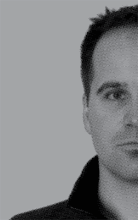Amergent Music Statement
Where affect is a condition that produces emotion, Amergence is a phenomenon of consciousness. This term characterizes emergent behavior with an additional, psychological dimension.
Amergence refers to behavior that can be witnessed and read. In our mediated world emergence is a given, but through further observation (to entend in the Lefebvre-ian sense of noticing and understanding) we find amergence. It reveals subjective details of the emergent behavior that surrounds us.
A work of Amergent music is rooted in the innate dynamics of a media technology. It must understand and recognize the functioning order of the environment or platform that supports it. In terms of the "content" or "subject" of the work, that which is to be communicated or explored (via mediated interaction) is organized into sonic spaces, each of which is subject to change. This arrangement works to represent degrees of potential or possibility. Nothing is black and white. Fluctuations within a space, or novelty that becomes apparent through the layering of several spaces, points to a world characterized by nuance. Kevin Lynch describes buildings, sidewalks, and other urban features as "legible;" useful for the construction of personal narratives. "A landscape whose every rock tells a story may make difficult the creation of fresh stories" (The Image of the City, 1960). Similarly, Amergent music does this for mediated interaction, where use of a system, or choices within that system, manifest a sonic synergy coupling the observer and the observed. The emergence of mediated interaction is made "legible" through sound as music.
This statement is modified from the original version which appeared in Dérive en Mille Sons "Drifting in a Thousand Sounds" a psychogeographic approach to mobile music & mediated interaction, a paper written for the 2009 Spark Festival of Electronic Music & Arts.








